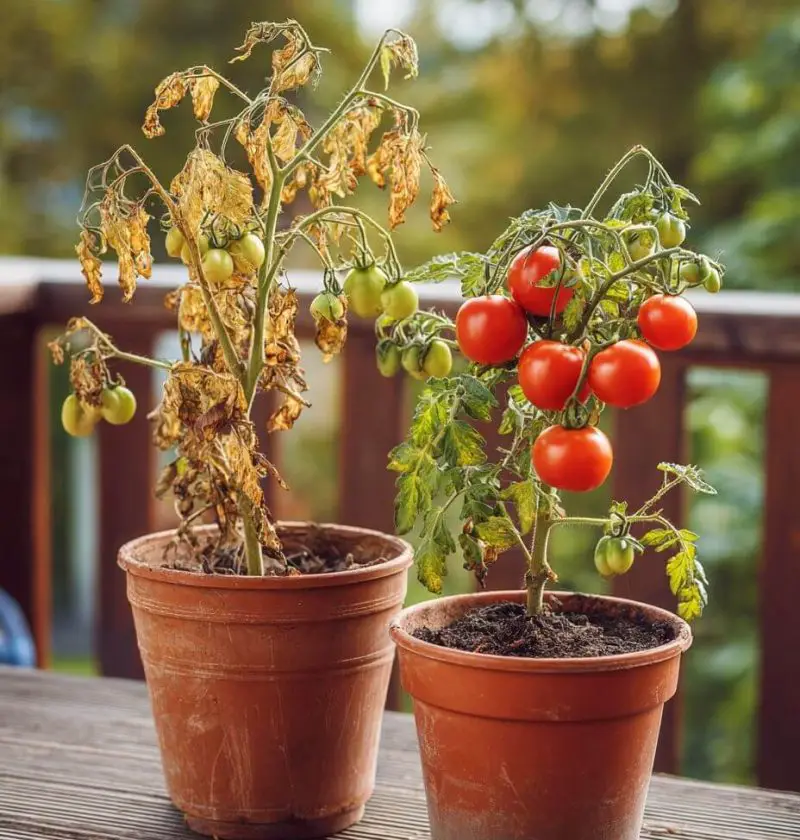A couple summers ago, I had the kind of tomato garden that made me feel like I really knew what I was doing. Fat, glossy green leaves. Clusters of baby fruit. I was already planning who was getting fresh tomatoes in a brown paper bag.
And then one morning… they wilted.
Not just a little droop — like, fully hunched over, leaves sad and limp like they’d had a rough night. I went from proud tomato mama to full-blown panic mode in about 30 seconds.
Sound familiar?
If your tomato plants are looking worse for wear and you’re not sure why—don’t beat yourself up. I’ve been there. A lot of us have. Let’s walk through what might be going on, and how to fix it (including that Epsom salt thing you’ve probably seen online — it’s not just hype).
Why Your Tomatoes Are Throwing a Fit
Let’s be real: wilting is a drama move. Tomatoes don’t gently suggest something’s wrong—they throw themselves on the floor like toddlers. But behind all that flopping is usually a pretty fixable issue.
Here are the big ones I’ve run into — and how to tell which one you’re dealing with.
1. You’re Loving Them Too Much
I’ll just say it: overwatering is the #1 mistake I’ve made with tomatoes. You see them droop, and your gut says, “They need water!” But soggy roots can’t breathe. When roots sit in water too long, they basically drown — and the plant wilts even though it’s soaked.
What to do:
Stick your finger in the dirt. If the top inch feels wet, hold off on watering. Make sure your pots have drainage holes. Raised beds help too.
2. Or Maybe They’re Just Plain Thirsty
On the flip side, underwatering is a quiet killer—especially during hot spells. Tomatoes don’t like going dry for long, and if they’re gasping, they’ll wilt fast.
Quick fix:
Water deeply at the base (not on the leaves). Early morning is best. And mulch around the plant with straw or leaves to hold the moisture in.
3. The Soil’s a Hot Mess
Tomatoes are a little bougie. If the soil’s too dense, it holds too much water. If it’s too loose, it dries out fast. Either way, the roots get stressed and, yep, you’ll see wilting.
Try this:
Mix in compost. It helps balance moisture and feeds the plant, too. And if you haven’t checked your soil pH in a while (or ever—no shame), tomatoes prefer it between 6.0 and 7.0.
4. Heat Waves (and Cold Snaps) Are No Joke
I’ve seen tomato plants look just fine at 9 a.m. and be totally wilted by 3 p.m. because of the heat. They sometimes “recover” in the evening, but if the stress keeps up, it’ll take a toll.
Tip:
Give them some afternoon shade during heatwaves. I’ve even draped an old sheet over some bamboo sticks — not fancy, but it worked.
And if you’re getting surprise chilly nights? A row cover or old fleece blanket after sunset can help.
Save This Recipe
5. Tiny Bugs or Trouble in the Roots
If watering and shade don’t help, check under the leaves. You might spot aphids, spider mites, or whiteflies — tiny pests that suck the life out of the plant. Or worse, it could be a disease like Fusarium or Verticillium wilt hiding in the soil.
What I do:
Look for yellow spots, curling leaves, or sticky residue. Neem oil spray can help with bugs. For diseases, sadly, sometimes the best move is pulling the plant and rotating crops next year. I know — it hurts.
6. They’re Hungry
Tomatoes need nutrients — not just water and sun. Without enough magnesium or potassium, they can’t do their job, and wilting is one of the ways they show it.
And this is where that “viral hack” comes in…
The Epsom Salt Trick That Actually Helped
So, full honesty? I rolled my eyes the first time I saw someone online swear by Epsom salt for tomatoes. But after that wilting incident a couple summers back, I gave it a try.
Here’s what I did:
1 tablespoon of Epsom salt (magnesium sulfate)
1 gallon of water
Poured right at the base, every 2–3 weeks
Within a week or two, the leaves perked up, and the plant just looked… happier. It’s not magic, but if your soil is low in magnesium, it can make a real difference.
Bonus tip: It also helps prevent blossom end rot, which is that gross black patch that sometimes shows up on the bottom of the fruit. You know the one.
A Few More Tips I Wish I Knew Earlier
-
Mulch. Always. Keeps roots cool, holds moisture, and keeps weeds down.
-
Don’t water from above. Wet leaves = fungal problems. Aim for the roots.
-
Prune the bottom leaves. It helps with airflow and disease prevention.
-
Don’t crowd your plants. More air and space = less stress.
You’re Not a Bad Gardener — You’re Just Learning
If your tomato plant is wilting right now and you’re feeling like a failure—please hear this: you’re not.
Tomatoes are tricky little divas. Even seasoned gardeners mess up sometimes. The fact that you care enough to troubleshoot it means you’re doing great.
Take a breath. Adjust what you need to. Try that Epsom salt trick if the signs point to it. And remember — plants are a lot like people. They bounce back when they feel supported.
If you’ve got your own tomato story — success, failure, or somewhere in between — I’d love to hear it. We’ve all been there. Let’s talk tomatoes down in the comments.

